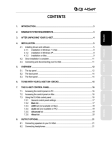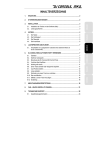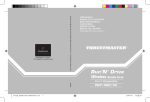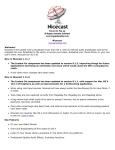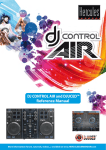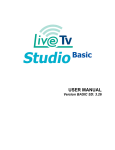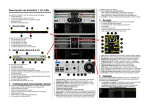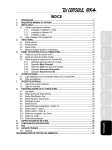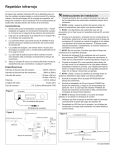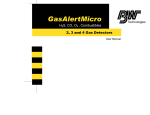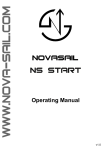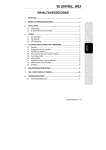Download 01_DJ Console Mk2_MAC Virtual DJ_eng
Transcript
1. INTRODUCTION .................................................................................................................2 2. SYSTEM REQUIREMENTS................................................................................................2 3. INSTALLATION ..................................................................................................................3 3.1. Installing drivers and software (Mac) ...........................................................................3 3.2. Power consumption .....................................................................................................3 6. USING THE DJ CONSOLE MK2 AT A PARTY .................................................................7 6.1. 6.2. 6.3. 6.4. 6.5. 6.6. 6.7. 6.8. 6.9. 6.10. 6.11. 6.12. Overview ......................................................................................................................7 Selecting an audio source ...........................................................................................8 Using the DJ Console Mk2 Control Panel ...................................................................8 Previewing with headphones .....................................................................................11 Working with tracks....................................................................................................11 Speeding up or slowing down a piece .......................................................................11 Creating cue points....................................................................................................12 Creating loops............................................................................................................13 Switching from one piece to another .........................................................................13 Getting on the microphone ........................................................................................15 Adding effects ............................................................................................................16 Scratching ..................................................................................................................16 7. MIDI STANDARD SUPPORT ...........................................................................................18 8. FREQUENTLY ASKED QUESTIONS ..............................................................................21 9. TECHNICAL SUPPORT ...................................................................................................22 ENVIRONMENTAL PROTECTION RECOMMENDATION........................................................24 DEUTSCH 5.1. Connecting speakers and/or an external mixer to your DJ Console Mk2 ...................7 NEDERLANDS CONNECTING SPEAKERS ...............................................................................................7 ITALIANO 5. The cover .....................................................................................................................4 The shoulder strap.......................................................................................................4 The top face .................................................................................................................5 The connectors ............................................................................................................6 FRANÇAIS OVERVIEW .........................................................................................................................4 4.1. 4.2. 4.3. 4.4. ESPAÑOL 4. ENGLISH CONTENTS 1. INTRODUCTION Your DJ Console Mk2 is a powerful and versatile piece of hardware that offers nearly unlimited possibilities in terms of what you can do with your music. You can use your DJ Console Mk2 on its own or with an external mixer, and you can mix both digital audio files and analog audio sources, including turntables. The DJ Console Mk2 is easy to learn and also offers many advanced functionalities, making it perfect for all users from beginners to seasoned professionals. The DJ Console Mk2 functions with digital audio files, including MP3s. We would like to draw your attention to the fact that musical creations are protected by copyright and that you must comply with all applicable legislations. We strongly encourage you to support artists by acquiring their works legally. 2. SYSTEM REQUIREMENTS Mac: Mac G4 / G5 1.5GHz / Intel® Core™ Duo 1.66GHz or higher 512MB RAM Operating system: Mac OS® X 10.4 or later Available USB port Headphones and/or amplified speakers CD-ROM or DVD-ROM drive Internet connection 100MB free hard disk space for some applications Microphone (optional) PC: Pentium® III / Athlon™ 1GHz or higher 512MB RAM Operating system: Windows® XP SP2, Vista 32-bit Available USB port Headphones and/or amplified speakers CD-ROM or DVD-ROM drive Internet connection 100MB free hard disk space for some applications Microphone (optional) 2/24 – User Manual 3. INSTALLATION Because drivers and software are constantly being developed, the ones provided on your CD-ROM may not be the most recent versions. You can visit the Hercules website (ts.hercules.com) to verify this and, if necessary, download the very latest versions. ENGLISH You must install your DJ Console Mk2’s drivers before connecting it to your computer. 3.1. Installing drivers and software (Mac) The installation CD-ROM appears on your desktop. - Double click the CD-ROM icon and navigate to the installer package. - Double-click the installer package and follow the on-screen instructions to launch installation of the DJ Console Mk2 drivers and Virtual DJ 3 software. You may be prompted to restart your computer once installation is complete. DEUTSCH FRANÇAIS - Insert the CD-ROM provided into your CD-ROM drive. The DJ Console Mk2 features a male connector, which means that you will need a power adapter with a female connector to attach to it. The inner pin in the male connector measures 2.0mm in diameter, while the maximum outer diameter for the connector is 6.5mm. This type of jack is referred to as a center positive polarity jack. Thus, when shopping for a power adapter, an adapter with the following specifications would be ideal: 9V DC/500mA; 2.1mm x 5.5mm plug; center positive polarity ( ). User Manual – 3/24 ITALIANO Should you wish, however, you can connect an optional power adapter (not included) and do away with worries about power consumption altogether. Your power adapter’s DC output should be at least 350mA, for output voltage of between 7V~9V; voltage outside of this range will result in power being drawn exclusively from your computer via USB. The power adapter must be regulated, thus ensuring that its output voltage is stable. A regulated power supply is clearly identified by the marking “Regulated”. Successfully tested power adapters include: -Uniross AC/DC Regulated 1.5 – 12V 700mA Universal mains Adaptor (UNI700RSF) -Uniross AC/DC Regulated 3 – 12V 1000mA Universal Adaptor (AD101705) ESPAÑOL Your DJ Console Mk2 is optimized to achieve low power consumption when connected to your computer via USB. If you are using a laptop, you can rest assured that your DJ Console Mk2 is not consuming high amounts of battery power as you mix and scratch your songs. Under the most taxing conditions, your DJ Console Mk2 will consume approximately 350mA of power. NEDERLANDS 3.2. Power consumption 4. OVERVIEW 4.1. The cover Your DJ Console Mk2 has a cover, allowing you to transport it without any danger of damaging the top face. The cover can also be attached to the underside of the DJ Console Mk2 as an inclined base, allowing you to use your DJ Console Mk2 under optimal conditions. By default, the cover is configured as an inclined base. To detach the cover: - Turn over the DJ Console Mk2 and place it on a flat surface. - Holding the DJ Console Mk2 with one hand, take hold of the cover by the OPEN opening. - Pull the cover up towards you, pulling up on one side and then the other in order to detach the cover. To replace the cover: - Position the tabs on the lower part of the cover in the corresponding slots on the DJ Console Mk2. - Apply pressure on both sides of the cover where the word CLOSE appears until it snaps into place. 4.2. The shoulder strap Your DJ Console Mk2 also features a shoulder strap for easy transportation. To install the shoulder strap: - Thread the Velcro flaps through the two buckles on the DJ Console Mk2. - Attach the flaps to the Velcro band. 4/24 – User Manual 4.3. The top face User Manual – 5/24 ESPAÑOL 1. Cut or boost Bass/Medium/Treble frequencies 2. Change music speed (pitch/master tempo) / tweak volume in real time 3. Add effect, cue point (song position), loop on the fly 4. Mouse emulation or track selection 5. LEDs indicating the current mode at a glance 6. Audio source select button 7. Speed up or down for accurate mixing 8. Previous/next track or rewind/fast forward 9. Vinyl-style jog wheel 10. Swift cross fader for seamless mixing between the 2 decks 11. Auto-synchronize deck with other deck 12. Play/Pause song / Play from cue point Note 1: These are descriptions of the DJ Console Mk2’s default functions, which may vary according to the application you are using. Note 2: Mouse emulation is enabled via the DJ Console Mk2 Control Panel (please see section 6.3. Using the DJ Console Mk2 Control Panel ). ITALIANO NEDERLANDS DEUTSCH FRANÇAIS ENGLISH Your DJ Console Mk2 has a variety of controls allowing you to interact with DJ software. There are two sets of these controls, as the left and right sections of the DJ Console Mk2 each correspond to a separate deck in DJ software applications. Descriptions of the default function of each control are provided below. 4.4. The connectors Your DJ Console Mk2 features multiple connectors on the front and back faces. With these connectors you can connect multiple devices, as illustrated in the diagrams below: Back face Stereo RCA inputs: Deck A (1/2), Deck B (3/4) RCA and minijack analog outputs: speaker system(s) and/or external mixer Grounding screws for phono inputs Optional power input Line In/Phono In switches (Phono In features a special phono preamp) Front face Microphone volume control/Talkover button (press to enable/disable) Headphone volume control Microphone input: mono microphone Peak volume indicator 6/24 – User Manual Headphone output selector Headphone input - Make sure that your computer is switched off and that the optional power adapter is disconnected, if you have one. - Connect your main set of speakers to the Output 1/2 RCA plugs (plug 1 corresponds to the left speaker, plug 2 to the right speaker) or to the Output 1/2 minijack plug. - If you have a second set of speakers (monitoring speakers, for example), connect the speakers to the Output 3/4 RCA plugs (plug 3 corresponds to the left speaker, plug 4 to the right speaker) or to the Output 3/4 minijack plug. You can also connect an external mixer to these plugs. FRANÇAIS 5.1. Connecting speakers and/or an external mixer to your DJ Console Mk2 DEUTSCH Two types of connectors are available for connecting speakers: RCA and minijack. An RCA plug corresponds to a channel, while a minijack plug corresponds to an output (composed of two channels), which is why there are 4 RCA plugs and 2 minijack plugs. Select the type of plug according to the type of speakers you will be connecting. Normally, Outputs 1/2 will be used for your live mix playing in the room, and Outputs 3/4 will be used for monitoring or connecting an external mixer. The Outputs 3/4 connector and the headphone jack always output the same audio data. ENGLISH 5. CONNECTING SPEAKERS You are now about to learn everything a DJ needs to know to host his or her first parties. Let’s start at the beginning, namely setting up the party: no DJ would allow himself to arrive unprepared, which is why he would have organized his material and selected his records beforehand. You should do the same by sorting through your music. Have a good look through your collection of CDs as well as MP3 and AIFF (for Mac) files and select the songs you are going to use. In order to be able to mix tracks effectively, you must know the pieces perfectly. When you’re ready, make sure that you have all the hardware you will need. Got your computer, DJ Console Mk2, a pair of speakers, headphones and microphone handy? Perfect, then you’re ready to go! You’re probably asking yourself: and now, how do I get started? By way of introduction, here are the basic principles of DJing: a DJ works with two decks (or turntables). The first deck plays one part of the musical piece, while the DJ uses the second deck to listen to the next part on his headphones. He can then work on this second part (speed it up so that it is at the same tempo as the rest of the piece, etc.) before playing it out loud. At the end of a part, the DJ plays the part on the other deck by doing a mix, which is to say a blending of the two parts creating a perfect transition. User Manual – 7/24 ITALIANO 6.1. Overview ESPAÑOL 6. USING THE DJ CONSOLE MK2 AT A PARTY NEDERLANDS Your speakers and/or external mixer are now ready for use with your DJ Console Mk2. Please read through the following sections to learn more about the art of DJing. We also recommend that you consult the help documentation of the software supplied with your DJ Console Mk2 for additional information. 6.2. Selecting an audio source Each deck is equipped with an audio source select button, located next to that deck’s volume slider. Using the audio source select button, you can choose the audio source to be used on that deck. The corresponding LED indicates the mode you are in. - LED is off: You are in Input mode. The deck is using what is coming from the corresponding inputs (1/2 for Deck A, 3/4 for Deck B). This is perfect if you have a turntable connected to one of the inputs, for example, and want to scratch using the turntable itself. - LED is on: You are in Computer mode. The deck is using what is coming from your computer, such as MP3 files. You can manipulate the audio using your DJ Console Mk2 in a variety of ways (mix/scratch, adjust Bass, Medium and Treble frequencies, etc.). You will use a software application, such as Virtual DJ, to select your playlist, add effects, set loops, cue points and so on. For information on locking into a mode, please see section 6.3. Using the DJ Console Mk2 Control Panel. 6.3. Using the DJ Console Mk2 Control Panel To access the DJ Console Mk2 Control Panel, browse to Applications/Hercules/DJ Console Mk2/Control Panel. The Control Panel allows you to manage your DJ Console Mk2’s various settings. - Output Channels: There are 2 sets of sliders (1-2, 3-4), which function as master volume controls for the corresponding outputs. You can alter the balance (left/right) using the balance sliders on top of each output channel slider. The pictograms below each output channel slider display whether the corresponding deck is in Computer or Input mode (a computer icon for Computer mode, a turntable icon for Input mode). You can lock into a mode by clicking the lock icon beside each pictogram: red means it has been locked. 8/24 – User Manual - Input Channels: To enable microphone recording or recording of your inputs, click the microphone or line input icons at the bottom of this window. Please note that when recording your microphone, you temporarily lose the use of Inputs 1/2. - Talkover Attenuation: Here you can enable a function that lets you talk on your microphone over the music being played in the room, by attenuating or reducing the level of the music (please see section 6.10. Getting on the microphone). You can select an attenuation level using the slider (-3, -6 or -9 dB). The Talkover Attenuation button in this section lights up when this function is enabled. ENGLISH Main section: microphone on or off. When your microphone is on, the On Air indicator lights up; when your microphone is off, the On Air indicator goes dim. in this section Your headphone output status is also displayed in this section: Deck A, Deck B, Mix or Split (please see section 6.4. Previewing with headphones). FRANÇAIS Push the microphone volume control/talkover button on the console’s front face to turn your - Cross Fader Settings: This option allows you to select different presets for the cross fader, including the “Beatmix” curve (a dipless curve, or a curve with no dip), “Dipped” curve and “Scratch” curve. These different presets represent different points where the music cuts out as you move the cross fader from left to right and vice versa. The two sides of the curve (left and right) are always a mirror image of one another. You can also lock the cross fader in the left, right or center position. For example, it may be useful to lock it in the center position if you prefer to manually switch from one track to another using the volume sliders rather than the cross fader. That way, even if you move the cross fader, your output will stay locked in the center. - Use External Mixer: Select this option to send whatever is being played on Deck A to Outputs 1/2, and whatever is being played on Deck B to Outputs 3/4, allowing you to mix via an external mixer. You must also properly configure your DJ software to operate in external User Manual – 9/24 ESPAÑOL - Jog Wheels Settings: Here you can select whether to enable both jog wheels (default), or disable one or both of the jog wheels. ITALIANO NEDERLANDS DEUTSCH Advanced section: mixing mode. The cross fader does not function in this mode, nor does the headphone output selector. To use an external mixer with your DJ Console Mk2: - Connect your external mixer to the Output 1/2 and Output 3/4 RCA connectors: - Enable the Use External Mixer option. - Launch your mixing software. The sound played on Deck A is directed to Outputs 1/2 and the sound played on Deck B is directed to Outputs 3/4. To carry out headphone monitoring, you must connect the headphones to the headphone output on your external mixer. If you connect your DJ Console MK2 to an external mixer : - With a professional quality external mixer, we recommend that you set the level to +4dB. - If your external mixer is an entry-level model (which does not support +4dB), adjust the gain to a reduced level on the mixer. If you have connected an external audio source to your DJ Console MK2 and want to raise the sound level of this external source, you should connect the mixer between the external source and the DJ Console MK2, and adjust the gain on the external mixer. - Enable DJ Mouse: This option enables mouse emulation, allowing you to move the screen pointer via the ministick. About section: 10/24 – User Manual - Provides information regarding your DJ Console Mk2 Control Panel version. It is important that you provide this information to our Technical Support staff when contacting Hercules by phone or email. Your DJ Console Mk2 allows you to carry out this kind of headphone preview. You can select what you are listening to on your headphones using the headphone output selector, located on the DJ Console Mk2’s front face. - Deck A position: Hear what is being played on Deck A on your headphones. FRANÇAIS To prepare his musical line-up, a DJ does a headphone preview: he listens to a track on his headphones while the other one is being played over the speakers, allowing him to adjust the tempo so that the tracks flow seamlessly together. He can also add an audio effect, set a cue point (marker) to start up at a specific point in a track, create rhythmic loops, adjust Bass, Medium and Treble frequencies, etc. ENGLISH 6.4. Previewing with headphones - Deck B position: Hear what is being played on Deck B on your headphones. Note: In external mixer mode, the headphone output selector has no effect. 6.5. Working with tracks The following diagram illustrates the functions assigned to controls in Virtual DJ 3. Browse through track listing / Navigating within the tree structure Load track on deck B / Opening a folder Load track on deck A / Closing a folder Moving quickly through a track ESPAÑOL Navigate within the loaded track ITALIANO - Split position: In Virtual DJ, this function is not assigned. NEDERLANDS DEUTSCH - Mix position: Hear what is being played on Outputs 1/2 on your headphones. 6.6. Speeding up or slowing down a piece Now you are listening to one of the tracks on your headphones. The main reason for doing this is to synchronize the tempo, which consists of matching the speed of the piece you are listening to with the speed of the piece playing over the speakers. In this way you can mix the two pieces User Manual – 11/24 together smoothly when switching from one deck to another. There are two ways to regulate the speed of a piece: by adjusting the pitch, and the master tempo. On vinyl decks, the pitch allows one to adjust the rotation speed of the turntable. This adjustment therefore changes the speed of a piece by modifying its overall tonality (for example, a piece that has been sped up significantly will sound much more high-pitched, or sharper). The key correction function allows you to modify the pitch of music while keeping the same BPM. You can therefore use one of the DJ Console Mk2’s Pitch knobs to modify the pitch of a piece. Note: You must disable the auto-synch function on a deck in order to be able to change that deck’s pitch. The following diagram illustrates the functions assigned to controls in Virtual DJ 3. Pitch encoder Beat match / Beat Lock Pitch bend (+ / -) Beat match Please refer to the Virtual DJ 3 PDF manual for more information. 6.7. Creating cue points You can insert a cue point to start playback at a specific point in a track. The following diagram illustrates the functions assigned to controls in Virtual DJ 3. Set cue point (Buttons 1, 2, 3) Set/Start at defined cue point Please refer to the Virtual DJ 3 PDF manual for more information. 12/24 – User Manual 6.8. Creating loops You can also create loops, which are sections of a piece repeated to infinity. The following diagram illustrates the functions assigned to controls in Virtual DJ 3. Toggle loops ENGLISH Increasing the loop size (Button 1) Controlling the loop (on/off) (Button 2) FRANÇAIS Decreasing the loop size (Button 3) Your DJ Console allows you to work with both digital and analog audio sources. This section will give you some practical examples of how you can switch from one musical piece to another and from one audio source to another. Example: An MP3 file is being played on Deck A (the left-hand deck). The LED underneath the audio source select button is on, indicating that Deck A is in Computer mode. The Bass, Medium and Treble knobs have been adjusted for the perfect sound mix with the piece that is playing. The cross fader is pushed completely to the left, so only what is being played on Deck A will be heard by the audience. Let’s say that the next track you want to play is also an MP3 file. While the track on Deck A is playing, set the headphone output selector on the DJ Console Mk2’s front face to the Deck B position so that you can monitor Deck B (the right-hand deck) while you are getting your next track ready. Press the audio source select button on Deck B so that the LED is on, indicating that Deck B is also in Computer mode. Assign the musical piece of your choice to Deck B and then you’re ready to go. As the piece on Deck A is nearing its end, start moving the cross fader to the right at the same moment you launch playback on Deck B. You can adjust the Bass, Medium and Treble knobs to achieve the perfect gain for the piece being played on Deck B, if you haven’t done so already. Naturally, there are many ways to switch from one piece to another: you can move the cross fader User Manual – 13/24 ITALIANO The art of mixing consists of preparing the next piece while a given piece is being played. When the piece being played reaches its end, the DJ switches from one piece to the other progressively using the cross fader, which regulates the volume of the two decks. This technique enables you to avoid empty space between two pieces. ESPAÑOL 6.9. Switching from one piece to another NEDERLANDS DEUTSCH Please refer to the Virtual DJ 3 PDF manual for more information. slowly, create back-and-forth effects, etc. Just use your imagination! Once the cross fader is pushed completely to the right, only what is being played on Deck B will be heard by the audience. At this point you can either set the headphone output selector to the Mix position to hear what is being played on Outputs 1/2 on your headphones, or temporarily remove your headphones and just listen to the music over the speakers in the room. The following diagrams give you an idea of how the Bass, Medium and Treble knobs and cross fader are adjusted for the procedure described above. Piece A being played on Deck A in the room. The Bass, Medium and Treble knobs on Deck A are adjusted for the perfect sound mix. Switching from Deck A to Deck B (keep the cross fader in the center position for approximately 5 seconds while you adjust the Bass, Medium and Treble knobs on Deck A and Deck B). Once the knobs are in their new positions, you can move the cross fader all the way over to Deck B. The transition between two pieces should be perfect thanks to the pitch synchronization carried out previously. Should you notice a slight discrepancy, however, use the Pitch bend - / + buttons. These buttons are the equivalents of the DJ giving a little push to the vinyl on his turntable, or slowing down the deck with his hand. The pitch modification value increases the more the Pitch bend button is pressed. Let’s assume that you have a turntable connected to Inputs 1/2 (for Deck A), and that the next track you want to play is on a standard vinyl record on Deck A. While the track on Deck B is playing, set the headphone output selector on the DJ Console Mk2’s front face to the Deck A position so that you can monitor Deck A (the left-hand deck) while you are getting your next track ready. Press the audio source select button on Deck A so that the LED is off, indicating that Deck A is in Input mode. Cue up the record on your turntable connected to Deck A to the spot where you want the music to start playing. 14/24 – User Manual 6.10. Getting on the microphone Have an announcement to make? A dedication? Speak up while your music is playing and talk to your public! The attenuation function allows you to be heard by reducing the ambient volume. ENGLISH As the piece on Deck B is nearing its end, start moving the cross fader to the left at the same moment you start up playback on your turntable connected to Deck A. Once the cross fader is pushed completely to the left, only what is being played on Deck A will be heard by the audience. Set the headphone output selector to the Mix position or remove your headphones. Now that your song is playing, you can even scratch the record on your turntable (assuming your turntable is designed for scratching). - Once you’ve said what you have to say, press the microphone volume control knob/talkover button once more. The On Air indicator goes dim. Talk-over is no longer enabled. For details on how to record using the microphone, please see section 6.3. Using the DJ Console Mk2 Control Panel. If the Peak indicator lights up while you’re talking: This means that the signal being received is too high: the sound from the microphone will saturate at a certain level, with a resulting loss of sound information. ESPAÑOL - Adjust the input volume using the microphone knob. DEUTSCH The sound of the music over the speakers decreases and the On Air indicator lights up in red in the interface, indicating that your voice will be broadcast over the speakers in the room. You can now go ahead and address the crowd. NEDERLANDS microphone volume control knob/talk-over button. ITALIANO - Press the FRANÇAIS - Select an attenuation level using the slider (-3, -6 or -9 dB) in the Main tab of the Control Panel. User Manual – 15/24 6.11. Adding effects You can assign an effect to the master output, meaning that it will be applied to both decks. The following diagram illustrates the functions assigned to controls in Virtual DJ 3. Jumping to the last effect in the list (Button 1) Toggle effects Controlling the effect (on/off) (Button 2) Switching to the next effect (Button 3) Please refer to the Virtual DJ 3 PDF manual for more information. 6.12. Scratching The DJ Console Mk2 allows you to scratch your digital music in the same way that a DJ scratches vinyl records. To do this you will use the DJ Console Mk2’s jog wheels, together with the cross fader to boost/interrupt the sound. The following diagram illustrates the functions assigned to controls in Virtual DJ 3. Use jog wheel to scratch Use jog wheel to scratch There are many scratch effects, the best-known of which are described below: Baby Scratch No need to use the volume control for this basic scratch. It consists of doing a forward scratch, immediately followed by a backward scratch. 16/24 – User Manual ESPAÑOL ITALIANO NEDERLANDS Pass-Pass The Pass-Pass is not a scratch technique, strictly speaking, since it uses the scratch as well as other elements (pitch, cross fader, etc.) to create new compositions. To carry out this technique you must play the same piece on both decks, and then it’s up to you to make use of the DJ Console Mk2’s functions to create new rhythmic combinations by alternating your manipulations on each deck. A perfect mastery of the cross fader and of the basic scratch techniques is required, as well as a good sense of rhythm and excellent familiarity with the piece. FRANÇAIS Backward Scratch The reverse of the Forward Scratch: you must do a backward scratch and then quickly lower the volume to its minimum setting just before doing the forward scratch, and then restore the volume. DEUTSCH Forward Scratch You must do a forward scratch and then quickly lower the volume to its minimum setting before doing a backward scratch to return to the initial position and restore the volume. Only the forward scratch will be audible. ENGLISH Tear Scratch The Tear Scratch doesn’t use the volume control either. As with the Baby Scratch, you do a forward scratch followed by a backward scratch, but this backward scratch is broken down into two different speeds: you must first scratch quickly, and then slowly. Thus, the different steps are as follows: forward scratch, quick backward scratch, slow backward scratch. User Manual – 17/24 7. MIDI STANDARD SUPPORT Your DJ Console Mk2 can function as a MIDI controller: the buttons and potentiometers can send and receive MIDI signals that will then be interpreted by software. In software that accepts MIDI commands, you must select your DJ Console Mk2 as the MIDI controller. 3 signal types can be sent: simple instructions (pressed or released status) for the 28 buttons and the headphone output selector, range of values (from 0 to 127, depending on the position) for the 6 Bass/Medium/Treble potentiometers, the 3 sliders and the ministick, and variable speed modifiers (the value varying according to the rotation speed) for the 2 pitch adjustment potentiometers and the 2 jog wheels. MIDI input commands: DJ Console Mk2 control Left Play/Pause Left Cue Left Prev. Track Left Next Track Left Pitch Bend “-” Left Pitch Bend “+” Left AutoBeat Select Left Mouse Button Left Master Tempo Left FX Select Left FX “1” Left FX “2” Left FX “3” Right Play/Pause Right Cue Right Prev. Track Right Next Track Right Pitch Bend “-“ Right Pitch Bend “+” Right AutoBeat Select Right Mouse Button Right Master Tempo Right FX Select Right FX “1” Right FX “2” Right FX “3” Left Deck Audio Source Select Right Deck Audio Source Select MIDI message B0 08 Value B0 09 Value B0 0B Value B0 0C Value B0 14 Value B0 13 Value B0 0A Value B0 1B Value B0 16 Value B0 07 Value B0 0F Value B0 0E Value B0 0D Value B0 02 Value B0 03 Value B0 05 Value B0 06 Value B0 18 Value B0 17 Value Message type Value description Button - Toggling Output Button - Toggling Output Button - Toggling Output Button - Toggling Output Button - Toggling Output Button - Toggling Output Button - Toggling Output Button - Toggling Output Button - Toggling Output Button - Toggling Output Button - Toggling Output Button - Toggling Output Button - Toggling Output Button - Toggling Output Button - Toggling Output Button - Toggling Output Button - Toggling Output Button - Toggling Output Button - Toggling Output 7F: Pressed – 00: Released 7F: Pressed – 00: Released 7F: Pressed – 00: Released 7F: Pressed – 00: Released 7F: Pressed – 00: Released 7F: Pressed – 00: Released 7F: Pressed – 00: Released 7F: Pressed – 00: Released 7F: Pressed – 00: Released 7F: Pressed – 00: Released 7F: Pressed – 00: Released 7F: Pressed – 00: Released 7F: Pressed – 00: Released 7F: Pressed – 00: Released 7F: Pressed – 00: Released 7F: Pressed – 00: Released 7F: Pressed – 00: Released 7F: Pressed – 00: Released 7F: Pressed – 00: Released B0 04 Value Button - Toggling Output 7F: Pressed – 00: Released B0 1C Value B0 1A Value B0 01 Value B0 10 Value B0 11 Value B0 12 Value Button - Toggling Output Button - Toggling Output Button - Toggling Output Button - Toggling Output Button - Toggling Output Button - Toggling Output B0 1D Value Button - Toggling Output B0 1E Value Button - Toggling Output Headphone Deck A B0 21 Value Button - Toggling Output Headphone Deck B B0 22 Value Button - Toggling Output 7F: Pressed – 00:Released 7F: Pressed – 00: Released 7F: Pressed – 00: Released 7F: Pressed – 00: Released 7F: Pressed – 00: Released 7F: Pressed – 00: Released 7F: External source – 00: USB Streaming 7F: External source – 00: USB Streaming 7F: Mode selected – 00: Mode deselected 7F: Mode selected – 18/24 – User Manual Button - Toggling Output Cross Fader B0 31 Value Analog – Coarse (128 values) Left Jog Wheel B0 36 Value Incremental – Coarse Right Jog Wheel B0 37 Value Incremental – Coarse Left Pitch Knob B0 34 Value Incremental – Coarse Right Pitch Knob B0 35 Value Incremental – Coarse Left Bass Knob B0 2E Value Left Medium Knob B0 2F Value Left Treble Knob B0 30 Value Right Bass Knob B0 2B Value Right Medium Knob B0 2C Value Right Treble Knob B0 2D Value Left Volume Slider B0 32 Value Right Volume Slider B0 33 Value Ministick Y-Axis B0 39 Value Ministick X-Axis B0 28 Value Analog – Coarse (128 values) Analog – Coarse (128 values) Analog – Coarse (128 values) Analog – Coarse (128 values) Analog – Coarse (128 values) Analog – Coarse (128 values) Analog – Coarse (128 values) Analog – Coarse (128 values) Analog – Coarse (128 values) Analog – Coarse (128 values) 00 > 7F: Full Left > Full Right 7F > 40: CCW Slow>Fast – 01 > 3F: CW Slow>Fast 7F > 40: CCW Slow>Fast – 01 > 3F: CW Slow>Fast 7F > 40: CCW Slow>Fast – 01 > 3F: CW Slow>Fast 7F > 40: CCW Slow>Fast – 01 > 3F: CW Slow>Fast 00 > 7F: Full CCW > Full CW 00 > 7F: Full CCW > Full CW ENGLISH B0 24 Value FRANÇAIS Headphone Mix 00: Mode deselected 7F: Mode selected – 00: Mode deselected 7F: Mode selected – 00: Mode deselected 00 > 7F: Full CCW > Full CW 00 > 7F: Full CCW > Full CW 00 > 7F: Full CCW > Full CW 00 > 7F: Full CCW > Full CW 00 > 7F: Full Down > Full Up 00 > 7F: Full Down > Full Up DEUTSCH Button - Toggling Output NEDERLANDS B0 23 Value 00 > 7F: Full Up > Full Down 00 > 7F: Full Left > Full Right Note: CW = Clockwise; CCW = Counterclockwise. ITALIANO Headphone Split ESPAÑOL Continued on following page. User Manual – 19/24 MIDI output commands: DJ Console Mk2 control Left Play/Pause Left Play/Pause Blinking Left Cue Left AutoBeat Left Master Tempo Left FX Left Cue 123 Left Loop MIDI message B0 08 Value B0 00 Value B0 09 Value B0 0A Value B0 16 Value B0 0F Value B0 0E Value B0 0D Value Deck Selection B0 7E Value Update Analog Controls Right Play/Pause Right Play/Pause Blinking Right Cue Right AutoBeat Right Master Tempo Right FX Right Cue 123 Right Loop B0 7F Value B0 02 Value B0 05 Value B0 03 Value B0 04 Value B0 1A Value B0 10 Value B0 11 Value B0 12 Value 20/24 – User Manual Value description 00: Off – 7F: On 00: Off – 7F: On 00: Off – 7F: On 00: Off – 7F: On 00: Off – 7F: On 00: Off – 7F: On 00: Off – 7F: On 00: Off – 7F: On 00 = Deck A Computer mode + Deck B Computer mode 04 = Deck A Computer mode + Deck B Input mode 08 = Deck A Input mode + Deck B Computer mode 0C = Deck A Input mode + Deck B Input mode 00 = Do not update – 7F = Update 00: Off – 7F: On 00: Off – 7F: On 00: Off – 7F: On 00: Off – 7F: On 00: Off – 7F: On 00: Off – 7F: On 00: Off – 7F: On 00: Off – 7F: On 8. FREQUENTLY ASKED QUESTIONS 5. What are DJ Console Mk2’s audio sampling rates? DJ Console Mk2 hardware sampling is 16-bit/44.1KHz in Mac OS. ESPAÑOL ITALIANO 6. Is DJ Console Mk2 also compatible with PC? Yes, DJ Console Mk2 is also compatible with PC (please see section 2. System Requirements). Drivers and software for PC are also included on the installation CD-ROM. FRANÇAIS 4. Will DJ Console Mk2 function when connected to a USB hub? Yes, as long as the USB hub’s power supply is connected, since DJ Console Mk2 needs a USB port’s full power in order to function properly. DJ Console Mk2 also works without an external power supply when connected directly to a PC’s integrated USB port, or you can use an optional power adapter if you are using a laptop and are concerned about battery power (please see section 3.2. Power consumption). DEUTSCH 3. Is DJ Console Mk2 a MIDI controller? Yes, DJ Console Mk2 functions as a MIDI controller and can send and receive MIDI commands. Please see section 7. MIDI standard support. NEDERLANDS 2. Can I use DJ Console Mk2 without a computer? No, DJ Console Mk2 cannot function at all without being connected to a computer. ENGLISH 1. Can I use DJ Console Mk2 with DJ software for Mac other than Virtual DJ? Yes: A variety of DJ software applications for Mac are compatible with DJ Console Mk2, including DJ-1800 and MegaSeg, with more and more programs integrating compatibility on a continual basis. Please check with the publishers of other DJ software for details on whether their software is currently compatible with DJ Console Mk2. User Manual – 21/24 9. TECHNICAL SUPPORT If you encounter a problem with your product, please go to http://ts.hercules.com and select your language. From there you will be able to access various utilities (Frequently Asked Questions (FAQ), the latest versions of drivers and software) that may help to resolve your problem. If the problem persists, you can contact the Hercules products technical support service (“Technical Support”): By email: In order to take advantage of technical support by email, you must first register online. The information you provide will help the agents to resolve your problem more quickly. Click Registration on the left-hand side of the Technical Support page and follow the on-screen instructions. If you have already registered, fill in the Username and Password fields and then click Login. By telephone: United Kingdom 08450800942 Charges at local rate United States 1-866-889-5036 Free Monday to Friday from 7am to 11am and from Noon to 5pm Saturday and Sunday from 7am to Noon (Eastern Standard Time) Canada 1-866-889-2181 Free Monday to Friday from 7am to 11am and from Noon to 5pm Saturday and Sunday from 7am to Noon (Eastern Standard Time) Denmark 80887690 Free Monday to Friday from 1pm to 5pm and 6pm to 11pm (English) Saturday from 9am to 1pm and 2pm to 8pm Sunday from 10am to 1pm and 2pm to 5pm Sweden 0200884567 Free Monday to Friday from 1pm to 5pm and 6pm to 11pm (English) Saturday from 9am to 1pm and 2pm to 8pm Sunday from 10am to 1pm and 2pm to 5pm Finland 0800 913060 Free Monday to Friday from 2pm to 6pm and 7pm to Midnight (English) Saturday from 10am to 2pm and 3pm to 9pm Sunday from 11am to 2pm and 3pm to 6pm Monday to Friday from Noon to 4pm and 5pm to 10pm Saturday from 9am to Noon and 1pm to 7pm Sunday from 9am to Noon and 1pm to 4pm 9.1. Warranty information Worldwide, Guillemot Corporation S.A. (“Guillemot”) warrants to the consumer that this Hercules product will be free from material defects and manufacturing flaws for a period of two (2) years from the original date of purchase. Should the product appear to be defective during the warranty period, immediately contact Technical Support, who will indicate the procedure to follow. If the defect is confirmed, the product must be returned to its place of purchase (or any other location indicated by Technical Support). Within the context of this warranty, the consumer’s defective product will, at Technical Support’s option, be either repaired or replaced. Where authorized by applicable law, the full liability of Guillemot and its subsidiaries (including for indirect damages) is limited to the repair or replacement of the Hercules product. The consumer’s legal rights with respect to legislation applicable to the sale of consumer goods are not affected by this warranty. This warranty shall not apply: (1) if the product has been modified, opened, altered, or has suffered damage as a result of inappropriate or abusive use, negligence, an accident, normal wear, or any other cause not related to a material defect or manufacturing flaw; (2) in the event of failure to comply with the instructions provided by Technical Support; (3) to software not published by Guillemot, said software being subject to a specific warranty provided by its publisher. 22/24 – User Manual 9.2. Additional warranty provisions Copyright © 2007 Guillemot Corporation S.A. All rights reserved. This publication may not be reproduced in whole or in part, summarized, transmitted, transcribed, stored in a retrieval system, or translated into any language or computer language, in any form or by any means, electronic, mechanical, magnetic, photocopying, recording, manual or otherwise, without the prior written permission of Guillemot Corporation S.A. Disclaimer Guillemot Corporation S.A. reserves the right to make changes to specifications at any time and without notice. The information provided by this document is believed to be accurate and reliable. However, no responsibility is assumed by Guillemot Corporation S.A. either for its use or for the infringement of patents or other rights of third parties resulting from its use. This product may exist in a light or special version for PC integration or other purposes. Certain functions detailed in this manual may not be available in these versions. Wherever possible, a README.TXT will be included on the installation CD-ROM detailing the differences between the supplied product and the product described in the present documentation. End-user software license Agreement IMPORTANT: please read the Agreement carefully prior to opening and installing the Software. By opening the Software package, you agree to be bound by the terms of this Agreement. The Software enclosed in this package is licensed, not sold, and is only available under the terms of the present license Agreement. If you do not agree with the terms hereafter, you must promptly return the Software within 15 days, together with the entire contents of the box, to the place of purchase. The Guillemot Corporation S.A. Software (hereafter named the “Software”) is copyrighted by Guillemot Corporation S.A. All rights are reserved. The term “Software” refers to all documentation and related material, including drivers, executable programs, libraries and data files. The purchaser is granted a license to use the Software only. The licensee also agrees to be bound by the terms and conditions of the present Agreement concerning copyright and all other proprietary rights for any third party Software, documentation and related material included in the Software package. Guillemot Corporation S.A. reserves the right to terminate this license in the event of failure to comply with any of the terms or conditions laid out in the present Agreement. On termination, all copies of the Software shall immediately be returned to Guillemot Corporation S.A.; the purchaser remaining liable for any and all resulting damages. User Manual – 23/24 FRANÇAIS DEUTSCH NEDERLANDS Declaration of conformity EC COMPLIANCE NOTICE: this equipment has been tested and found to comply with the limits of the Council Directive 89/336/EEC of 3 May 1989 on the approximation of the laws of the Member States relating to electromagnetic compatibility, amended by Directive 93/68/EEC. In a domestic environment this product may cause radio interference in which case the user may be required to take adequate measures. CANADIAN COMPLIANCE NOTICE: this Class B digital apparatus meets all requirements of the Canadian Interference-Causing Equipment Regulations. USA COMPLIANCE NOTICE: this equipment has been tested and found to comply with the limits for a Class B digital device, pursuant to Part 15 of the FCC rules. Operation is subject to the following two conditions: (1) This device may not cause harmful interference, and (2) This device must accept any interference received, including interference that may cause undesired operation. These limits are designed to provide reasonable protection against harmful interference in a residential installation. This equipment generates, uses and can radiate radio frequency energy and, if not installed and used in accordance with the instructions, may cause harmful interference to radio communications. However, there is no guarantee that interference will not occur in a particular installation. If this equipment does cause harmful interference to radio or television reception, which can be determined by turning the equipment on and off, the user is encouraged to try to correct the interference by one or more of the following measures: - Reorient or relocate the receiving antenna. - Increase the separation between the equipment and receiver. - Connect the equipment into an outlet on a circuit different from that to which the receiver is connected. - Consult the dealer or an experienced radio/TV technician for help. ITALIANO Hercules® is a registered trademark of Guillemot Corporation S.A. Virtual DJ™ is a trademark of Atomix Productions. Apple®, the Apple logo, Mac OS®, iTunes® and Quicktime® are registered trademarks of Apple Computer, Inc. Intel® and Pentium® are registered trademarks of Intel Corporation. WMA®, Microsoft® Windows® 98 SE, Me, 2000, XP and Vista are either registered trademarks or trademarks of Microsoft Corporation in the United States and/or other countries. Velcro® is a registered trademark of Velcro Industries B.V. All other trademarks and brand names are hereby acknowledged and are property of their respective owners. Illustrations not binding. Contents, designs and specifications are subject to change without notice and may vary from one country to another. ESPAÑOL Trademarks ENGLISH In the United States of America and in Canada, this warranty is limited to the product’s internal mechanism and external housing. Any applicable implied warranties, including warranties of merchantability and fitness for a particular purpose, are hereby limited to two (2) years from the date of purchase and are subject to the conditions set forth in this limited warranty. In no event shall Guillemot Corporation S.A. or its affiliates be liable for consequential or incidental damage resulting from the breach of any express or implied warranties. Some States/Provinces do not allow limitation on how long an implied warranty lasts or exclusion or limitation of incidental/consequential damages, so the above limitation may not apply to you. This warranty gives you specific legal rights, and you may also have other legal rights which vary from State to State or Province to Province. License: 1. The license is granted to the original purchaser only. Guillemot Corporation S.A. retains all title to and ownership of the Software and reserves all rights not expressly granted. The licensee is not permitted to sub-license or lease any of the rights that are hereby granted. Transfer of the license is permitted, provided that the transferor does not retain any part or copy of the Software and the transferee accepts to be bound by the terms and conditions of the present Agreement. 2. The licensee may only use the Software on a single computer at any time. The machine-readable portion of the Software may be transferred to another computer provided it is previously erased from the first machine and there is no possibility that the Software can be used on more than one machine at any one time. 3. The licensee acknowledges the copyright protection belonging to Guillemot Corporation S.A. The copyright notice must not be removed from the Software, nor from any copy thereof, nor from any documentation, written or electronic, accompanying the Software. 4. The licensee is granted the right to make one back-up copy of the machine-readable portion of the Software on the condition that all copyright and proprietary notices are also reproduced. 5. Except where the present Agreement expressly permits, the licensee is strictly prohibited from engaging in, nor may he permit third parties to engage in, the following: providing or disclosing the Software to third parties; providing use of the Software in a network, multiple PCs, multiuser or time-sharing arrangement where the users are not individual licensees; making alterations or copies of any kind of the Software; making any attempt to disassemble, de-compile or reverse engineer the Software in any way or form, or engaging in any activity aimed at obtaining underlying information not visible to the user during normal use of the Software; making copies or translations of the User Manual. ENVIRONMENTAL PROTECTION RECOMMENDATION At the end of its working life, this product should not be disposed of with standard household waste, but rather dropped off at a collection point for the disposal of Waste Electrical and Electronic Equipment (WEEE) for recycling. This is confirmed by the symbol found on the product, user manual or packaging. Depending on their characteristics, the materials may be recycled. Through recycling and other forms of processing Waste Electrical and Electronic Equipment, you can make a significant contribution towards helping to protect the environment. Please contact your local authorities for information on the collection point nearest you. 24/24 – User Manual

























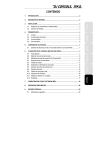
![[English] 450 KB](http://vs1.manualzilla.com/store/data/005878868_1-e5f7783ea728201c5d3bf440f5f55954-150x150.png)
![[English] 2.2 MB](http://vs1.manualzilla.com/store/data/005801224_1-360c03496a849957940b8f23b39f430e-150x150.png)
